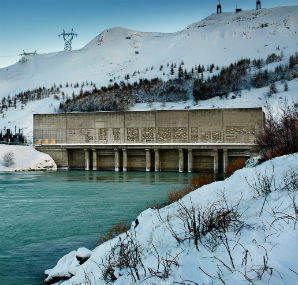Expansion of Búrfell hydropower station is due to start this year. As well as focusing on improving its current facilities, Icelandic power company Landsvirkjun has had to contend with volatile weather conditions in what has been described as a poor water year.

Icelandic power company Landsvirkjun is set to expand the Búrfell hydropower station by 100MW with construction to begin in spring 2016. The expansion will generate power for only part of the year as it will utilise water that bypasses the station during the summer months. However, installed capacity of the expansion will be utilised year-round to increase operational security and the flexibility of the electricity system. It is estimated that approximately 14% of the water flow (410GWh/yr) runs past the Búrfell plant on an annual basis.
Landsvirkjun announced its decision to expand Búrfell to the Icelandic National Planning Agency in May 2013. The agency published its findings in July 2013 where it stated that anything up to 140MW would be unlikely to have a significant environmental impact and not require an environmental impact assessment.
The installed capacity of the new power station is expected to be 100MW (one turbine) but there are plans to expand the station by a further 40MW, which could increase the generation capacity of the electricity system by anything up to 300GWh/yr. As electricity demands are expected to increase between 2016-20, the expansion offers increased flexibility in operations and the option of carrying out maintenance work at the current station without significant reductions to the energy supply.
Construction work on the proposed project is expected to begin in the spring of 2016 and will continue until the middle of 2018. As many as 100 employees will be involved in work carried out on-site during the second half of 2016, and 150 employees are expected to be on-site throughout 2017 and during the first half of 2018.
Renewal
When Landsvirkjun was established in 1965, it embarked on construction of Búrfell hydropower station which came on-line in 1969. It took almost ten years to complete and was the largest power station in the country until the inauguration of Kárahnjúkar in 2007.
The River Thjórsá is harnessed at Búrfell with a tailrace tunnel from the Bjarnarlón Reservoir to the powerhouse located in the Thjórsárdalur Valley. The station’s equipment was partially renewed in 1997-1999 and increased installed capacity to 270MW from 210MW.
Managing water budgets in a poor water year
Unseasonal weather variations have impacted upon Landsvirkjun’s water operations in 2015. Cold conditions in May and June in eastern parts of Iceland delayed reservoir filling. This was expected to change rapidly towards the end of June as temperatures should have increased, along with glacial ablation and water flow. However dominating northerly winds, with cold spells and heavy cloud coverage, affected weather conditions in July. Run-off from glaciers increased slightly but temperatures and sunlight levels reached a historical low in the lower regions of the Brúarjökull Glacier. The spring melting period in the highland areas began late, was slow and was one of the worst experienced in Landsvirkjun’s reservoir history.
By August snow in the area had melted completely. Flow rates which had been affected earlier in the year were now reliant on late summer precipitation and glacial ablation levels.
As Landsvirkjun said, the outlook for its reservoirs had been good at the end of last winter and there was heavy snow coverage in the Þjórsá area. However, the unusually cold and dry weather conditions in spring affected the water budget. The power company warned that the late spring made it unlikely that all of Landsvirkjun’s reservoirs would be full by the end of the summer and that it would have to evaluate the need for limiting power delivery in the winter if water inflow remained close to the lowest recorded levels.
In September Landsvirkjun decided to postpone any possible reduction in electricity supply to customers. The warmest day of the summer was measured on 7 September and there was rapid improvement to inflow rates as a result. The overall status of Landsvirkjun’s reservoirs continued to improved significantly and reservoir capacity in September was at 85.5%. It had been 69% at the end of August.
On 5 October 2015 Landsvirkjun made the decision to cancel any reductions to customer electricity supply due to substantial increases in inflow to the company’s reservoirs throughout September. However Landsvirkjun subsequently gave its customers one month’s prior notice of any future reduction to winter supply.
The weather in Iceland in September was ten degrees above the national average for the last ten years. Although this warm spell had a substantial effect on reservoir inflow levels, and ablation levels increased significantly, 2014-15 was still described as a poor water year. Landsvirkjun said its reservoirs would not reach full capacity and consequent weather conditions will affect any possible power reductions at the beginning of 2016.
All information and photographs courtesy of Landsvirkjun.
